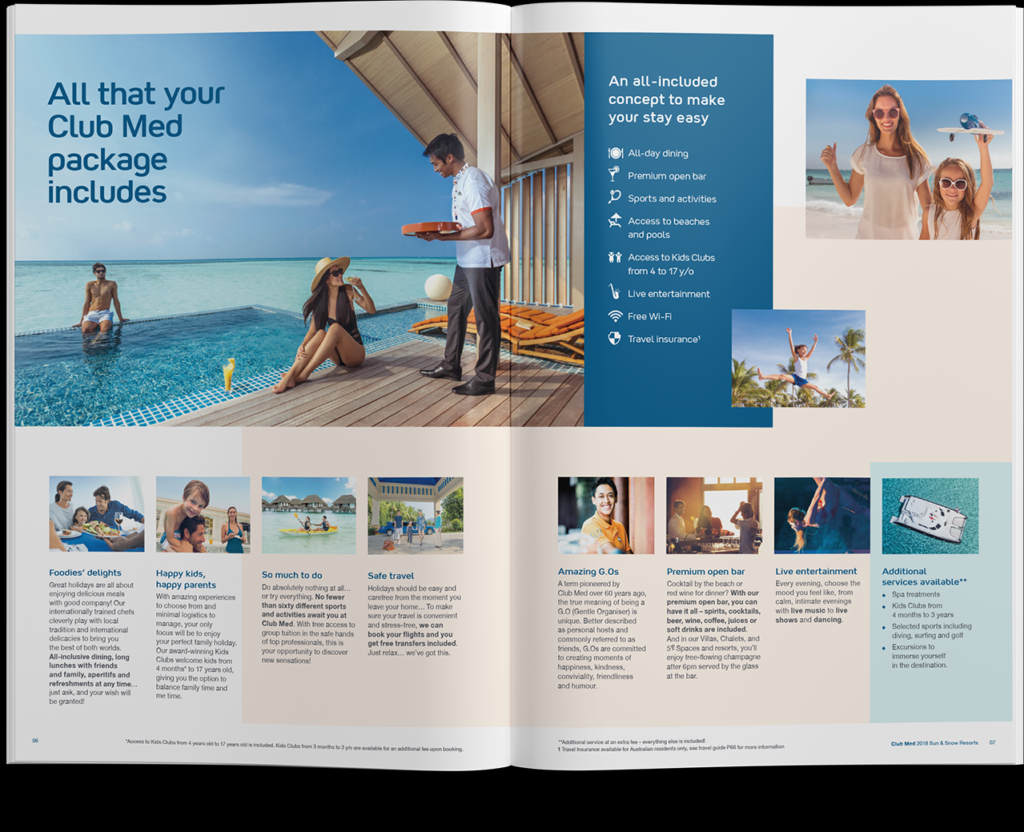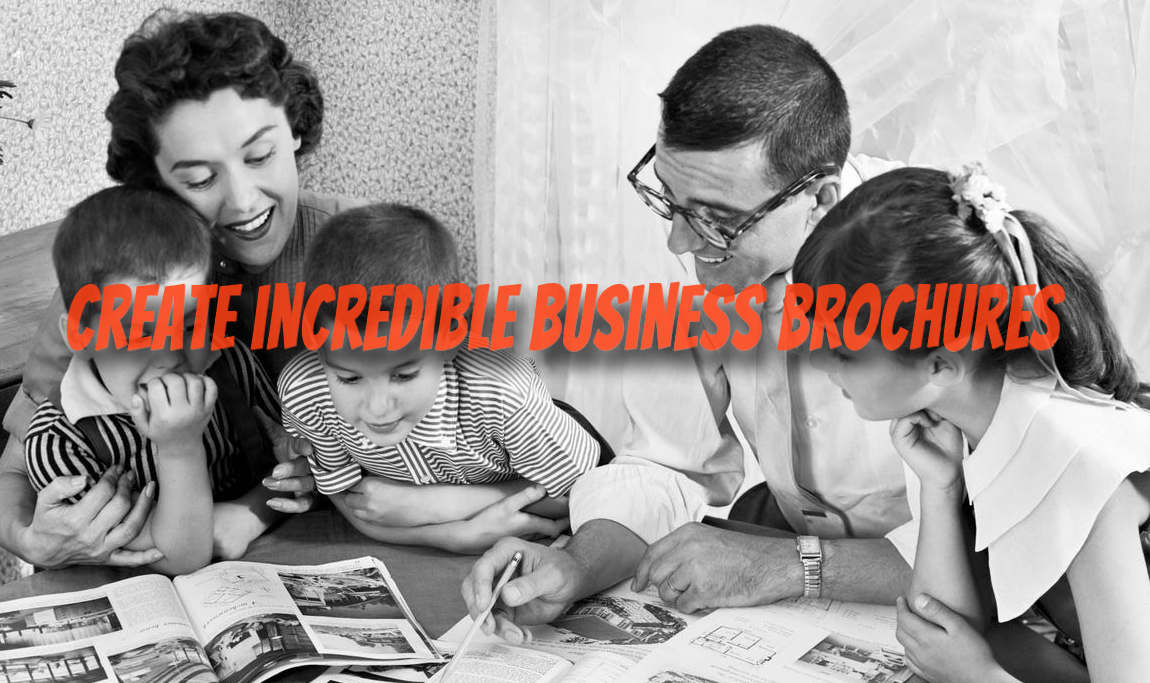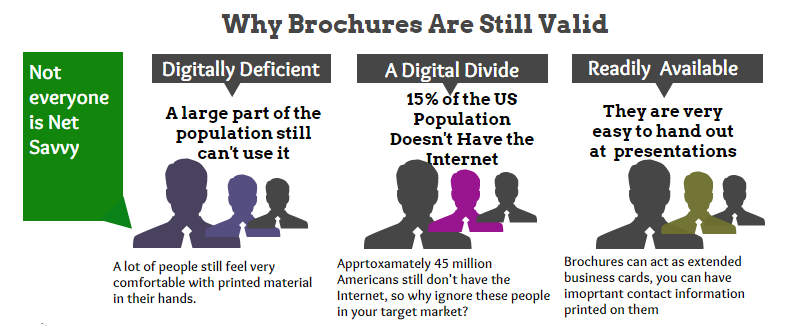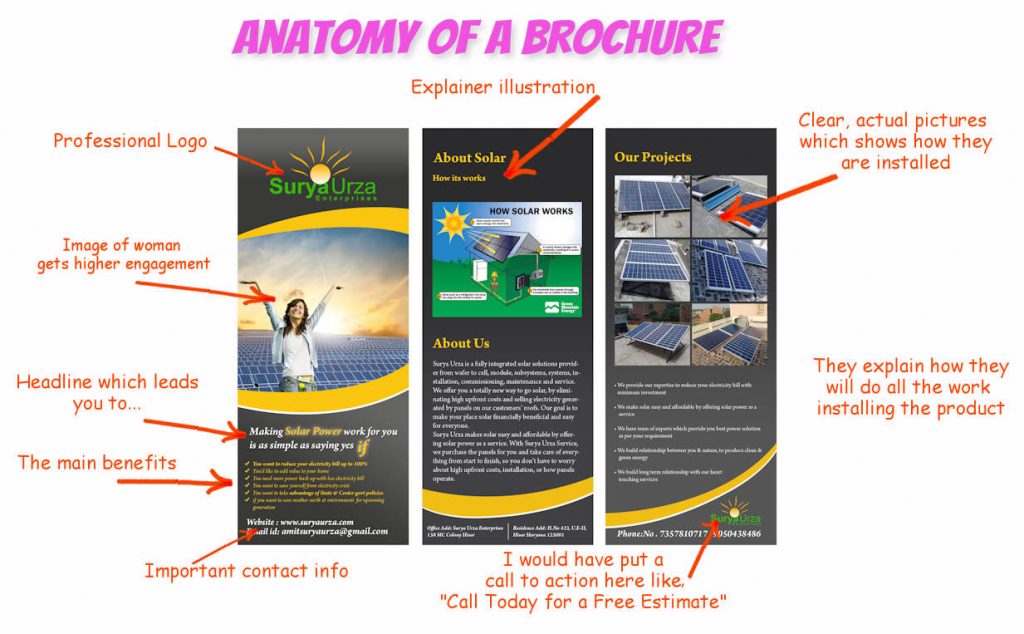Your company can use a business brochure.
Why?
If you’re only marketing online to promote your business, you should reconsider your strategy.
Using only one channel to market your business is dangerous. If for some reason your website dies or has a setback, your offline marketing is still there.
Yes, you should have a Web site or eCommerce site to sell your wares, no doubt.
But there are many opportunities to meet people face to face and hand them your sales material…
…And business brochures are a perfect solution for an opportunity like that.
Consider These Business Brochure Marketing Facts:
- It’s much easier to hand someone a business brochure than suggest that they navigate to a webpage to see your sales material
- Not everyone is Net-savvy. There’s still a large part of the population out there that doesn’t know how to use the Internet
- 15% of the US population (approximately 47 million people) still don’t have Internet access.
- Brochures can be sent through the mail. If your prospects are even mildly interested, they will at least glance at what you’ve sent them
- People hang on to brochures longer because they leave them lying around the office or home. Online it’s one click and they’re gone.
- Brochures can also act as extended business cards: you can have your name and phone number printed or stamped right on them
- A brochure will be directly in the hands of prospects if you’ve handed it to them, or they’ve gotten it through the mail. Not so with TV ads or the Internet
- Most people alive today were raised on printed materials. They feel very comfortable with it and that trend is continuing
One reason for a business brochure is so that the sales team has a visual representation of what they’re selling. Almost all sales presentations need a visual aid of some sort and brochures are perfect for that.
If your company’s brochure isn’t effective it’s probably because the copy and layout haven’t been created professionally.
Many businesses throw brochures together haphazardly without the slightest thought as to how the copy is written or how it’s laid out.
So, in this post, I’m going to show you how to build a compelling business brochure. If you follow these copywriting tips, you’ll be well on your way to creating a marketing piece you can use for years to come.
Business Brochure Copywriting Tips #1: Research Should be your First Step
Planning a brochure is very important because you must consider your customer’s needs and desires.
Consider these factors while planning your sales material:
- What niche or need in the market does your business fill?
- What problem do you solve for your target market?
- What are the biggest benefits you can offer a prospect?
- What desires or fears do your clients or prospects have?
- What steps of the sales process can your brochure help you or your sales staff with?
The more intelligence you have on your prospective clients and customers the better off you’ll be, and the easier it’ll be to create your brochure.
Business Brochure Copywriting Tips #2: Spy on Your Competitors
This is the same thing you would do if you were building a website. You’d check out your competitors (especially the ones who are killing it in their marketing space) and copy what they’re doing.
In the case of a business brochure, I’d try to get on the competition’s mailing list or ask them to send me one of their brochures. Once you have it, you can back engineer the piece to see why it works.
Also, search business brochures similar to yours to see what others in y0ur market are producing.

While researching this post, it was easier to find great incredible business brochures by searching for specific companies. For example, I did my searching like this: “Business Brochure Club Med” or “Club Med Brochure”.
If you just search “Business Brochures” you’ll get tons of generic brochures by businesses that want you to buy their services.
Here are some of the specific brochure results I found using my search method:
Business Brochure Copywriting Tips #3: Consider the Brochure’s Role
You need to figure out what the role of your business brochure is as it relates to your sales process.
For example, If you’re going to be selling pharmaceuticals your brochure is going to be talking about more than one product. When you’re selling a luxury vehicle, you’ll be using the brochure to point out the benefits and features of your product.
A dentist may want to use an informative brochure to write future appointments for their patients.
Here are a few different roles your brochure can play in the selling process:
Role 1 ― Selling services
If you’re using your brochure to sell services, you will need to include the following information in your brochure:
- Introduction ― Have a section that details the kind of services your company provides. Why should your company be chosen over all the others? (Unique Selling Proposition or USP)
- Procedure ― How does your company handle the business with clients?
- List of Services ― Describe to your potential clients the services you offer.
- Benefits ― This is where you’ll tell your prospects what you can do for them.
- Your Biographical Information ― Highlight your experience as it applies to your services.
- Testimonials ― Any accolades you can present from clients you have serviced in the past is validation.
- Fees and Terms ― This section will tell your prospects how much you are charging in a rate table as well as the terms of your services
- Call to Action ― You’ll need to tell your prospect what the next step is. (Having them call you is the best way.)
Role 2 ― The Company’s Representative
You need to consider your brochure as if it were a printed representative for your company. It’s used as supplemental information that helps the prospect or customers know more about your business.
One of the functions of a business brochure is to reassure or give the prospect comfort on their way to making a decision.
For example, a prospect who wants to buy investments from a brokerage will want to be reassured. They’ll probably want to know how long your company has been in business, how many clients you have, what’s unique about it, etc.
So, considering the nature of a business brochure, you’ll probably want to have these copywriting tips in the copy of your material:
Corporate Philosophy – This is your company’s mission statement and the standards it holds
History of Your Company – How many years your company has been in business and how it has fared in diverse situations during that time
Corporate Structure – This will outline the divisions, departments, branches, and other structural features worth noting in your company.
In addition to those elements above, there are all sorts of selling points you could cover in a corporate brochure, like:
- Awards your company has won
- References to articles written about your company
- Where your offices are located
- Number of employees
- Years in business
- Sales volume or records your company has set
- Markets your company deals in
- How your company ranks in the market
- Area your company covers geographically
There’s a lot more you could put into a corporate brochure, depending on the size of your brochure and how much you want to add to it.
Role 3―The Product or Catalog Brochure
Catalog brochures are the same as product brochures except they’re representing a group of products rather than a single one.
Another one of the copywriting tips I’d like to give you is not to take too much for granted. You should never assume that the prospect knows what you’re talking about.
You don’t want to kill any possible sales that are coming from people that are not savvy or new to your market.
Taking into consideration these issues, you’ll need to use include these points into your product brochure:
- The Introduction – Try to briefly describe the product, what it does and how it will benefit your reader. You need to point out the main benefit here if you can
- More benefits – Unless your product is a Popsicle stick, it’ll probably offer a wide range of benefits to your customers. You’ll need to pack as many of these into the copy as possible
- Features – This describes the color, make and model and other things the customers might find important. (Please do not confuse Features with Benefits. In my humble opinion, features are important, but benefits override everything else.)
- Who the Product is Made For – This describes who will benefit the most from using this product
- How it Functions – This tells the customer how the product works as well as what it can do for them.
In addition to the above information, you’ll need to include the following information:
- Pricing
- Support
- Technical Specs
- Brief Company Summary
- Guarantees or Warrantee Information
- What organizations your company belongs to like the Better Business Bureau
You also may want to have a section that answers any of the common questions that your company may have been asked in the past about the product or products.
So as you can see, you’ll need to plan differently for different brochures. However, using this post as a guide will help you understand the basics of creating a brochure that gets results and helps you sell your product.
3 Steps You Need to Take to Write the Copy For Your Brochure
Step 1 Researching – Gather Your Resources
This is where you’ll save most of your time writing compelling copy for your business’s brochure. Even though you’ll probably want to jump in with both feet and start writing, you’ll be far better prepared to write the copy for your brochure if you follow these steps.
If your company has already been promoting products or services, then this should be an easy way to do research. You need to collect up all the information possible on the products or services your company has used in the past.
When I work with clients, I ask them for any reports, technical drawings, specs, internal memos, etc. Anything which has been previously written will be a big help.
So, when you have been tasked to write the copy for a brochure in your company, make sure you gather these resources before you get started:
- Previous brochures
- Articles already written about your products or services
- Catalog copy already used (Make sure to update, if needed)
- Any annual, biannual, or quarterly reports that your company may already have on the product or service
- Specs on products
- Internet ads or websites
- Technical reports
- Comments from users
- Notes from developers
- Any PowerPoint notes used in presentations
- Videos online that explains your product or services
As a copywriter, you’ll probably be working with a designer in the production of a brochure. Taking on the responsibility of creating the actual design of the brochure is usually outside the scope of a copywriter.
However, if you do have the ability to create the design of the brochure and do it competently, make sure you charge the client for it.
Clients will be more than delighted to have you do the writing as well as design and think of it as one price, so you could easily get
Personally, as a graphic artist as well as a copywriter, I’d be more than delighted to do the design work. However, I am not a professional designer and, it’s better to leave it to professional graphic artists to handle the design.
Having said all that, I will tell you that your input to the graphic designer will be important.
Helping Your Designer with Microsoft Word
You should be able to create a mock-up to help your designer with Microsoft Word.
Here’s a video which explains how to do it:
Not only should you present charts and graphs, but you should also have the following:
- sidebars – These are small boxes that usually have additional information in them
- quotes – These are quoted areas in your brochure that draw attention to a point or statement made by someone important to the company
- Any clip art images, pictures or other graphics that are relevant to the piece
Use This Free Online Tool to Create a Mock-Up
If you want to create a quick mock-up to give either the client or the designer to give them a general idea of which direction to place the copy there’s a great online tool that’ll help you do this.
It is an online brochure design interface that you can use for free called Canva.

Canva is extremely similar to many of the free infographic sites on the Internet. Because it has a simple interface you can easily create a mock-up to show to a graphic designer to help them out.
To see how Canva works, watch the video below:
Step 2 Outlining Your Brochure
Once you have gathered up all of your resource material, you can now begin to put together an outline of your material.
If you’re not accustomed to putting together an outline, you should know that an outline is just like a skeleton. It’s the foundation that holds and strings all of your writing together.
While you don’t need to create a college-level outline, you should at least try to sketch out your main sections. Here is an idea of how you could create a halfway decent sketch of a product brochure:
- Introduction – This will tell your prospects what your product is all about. You could also go the traditional copywriting route and create an eyeball catching headline that’ll make people want to read more of what you have to offer.
I once saw a headline on a brochure for a group of rental offices that was an old historical house. The caption read: “Rent Your Place in History” Nothing dynamic, but it made the copy more interesting to read than, “Offices for Rent”.
If you’re having a hard time writing headlines, here’s two great posts on how to do that:
Neil Patel’s Step by Step Guide to Writing Powerful Headlines
Jon Morrow’s 52 Headline Hacks
- Benefits – These are points that tell the reader or prospect what the product (or service if it’s a service-oriented business) will do for them. These are probably the most important aspects of the copy itself.
III. Features – Features are highlighted parts of the unit that will also be beneficial or helpful in using the product. Once again, not to be confused with benefits that tell the prospect what the item will do for them.
- Applications – What the uses of the product are.
- Product Types Available for Purchase – This section will explain the different types of makes and models available and what their sizes and colors are.
(If you’re promoting service with your brochure, you can talk about the different types of services you can offer a client, as well as advantages and extra help you offer as a part of your package.)
- Technical Specs – Usually depending on the product you’re selling, you’ll have to include all sorts of information vital to running the unit such as:
- safety instructions
- storage conditions
- moisture issues
- temperature tolerances
- geographical operations (as in the case of cell phones)
- how to clean the unit
- compatibility with other units and operating systems
VII. Company Background – You will want to show the reliability of your company or business in this section. If you belong to any associations or reputable organizations that lend credibility to your organization, you’ll want to put it here.
VIII. Support and Service – This is where you’ll want to place your warranty information as well as repair policies, installation instructions, and training available information.
- Call to Action /Ordering Information – You should tell your prospects about the kinds of credit cards they can use to order with, as well as how they need to place the order. Also, if you have branch offices or sales representatives how they can contact them.
Once again, writing for a product and service is slightly different and can follow the same outline pretty much the same way. Of course, you’ll need to describe your services and treat them in much the same way you would a product.
(Actually, many business owners look at their services as if it were a product, so that may make it easier for you to think about your service-related business that way while writing your promotional piece.)
Outlining your brochure is a time consuming, yet vital step in getting your copy written. You need to do it no matter how much you want to skip ahead and start writing.
If you are having difficulty putting together an outline for your brochure, you can navigate to this free online tool to help you organize your thoughts:
Cambridge Rindge and Latin School Outline Maker
Step 3: Writing the Brochure
Once you have your research completed and your outline fleshed out, you can now begin to write. I can guarantee you; if you’ve taken those preliminary steps in preparing to write, your task at hand will be much, much easier.
In addition to a great headline at the onset of your copy, you’ll want to follow these guidelines while you write your copy:
- Make subheads just as punchy as your headline – Subheads are just like mini headlines for each section of your copy. Instead of having a subhead that says, “How to Contact Us” you could write “Call Us – We’re here for you!” Sounds more interesting that way, doesn’t it?
- When you’re writing a brochure, remember to write like you are sitting in a coffee shop next to the person, explaining to them what they need to know. Nothing sounds more boring to a reader than to listen to a college dissertation on how the Sonic Coffee Maker works.
- Remember to write in the voice of the culture you’re selling in. Writing for a hunting enthusiast is different than writing for an accounting client. There are different terms and even slang that can be used to promote your product or service.
- Remember, you are leading the prospect through a decision-making process, so try to have a logical progression to your writing.
- Use bullet points to point out different benefits and features. These short statements should be short and punchy, separating all the different points the prospect needs to know to make an intelligent decision.
- Make your prospect want to hang on to the brochure. If you’re selling cookware, including measuring charts comparing cups to tablespoons might come in handy. If you have a resort, a nice, detailed map might make people want to hang on to your brochure. A list of helpful tips and tricks always makes people want to hang on to your material. Try to brainstorm ways you can get prospective customers or clients to want to keep your brochure around.
- Finally, have a good call to action (CTA) and ordering information. There’s a good reason why you see “Call Right Now” prominently displayed in every infomercial. Also, if there is ordering information, make sure you take your time and make it foolproof. A good rule of thumb is to give a prospect several different ways they can order from you. The more easy ways they can order, the more likely they are to place one.
Conclusion
Yep, planning and writing your brochure is a lot of work, but if you plan it out, you can save a lot of time and have a far more successful promotional piece that you can use for years to come.
So, go forth, build your brochure and use it every chance you get. It’ll last you for years and bring in clients like you never thought possible.
To your continued success!








